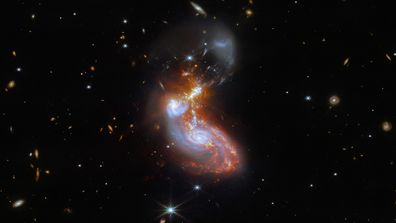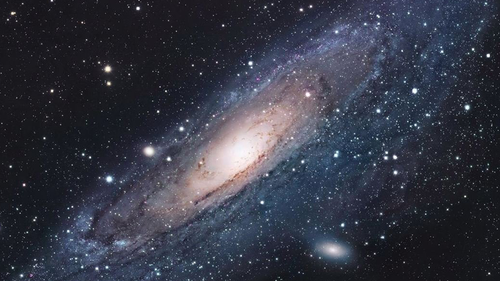By Josh Hohne
Nov 22, 2022
In their quest to uncover the origins of the Milky Way, a team of astrophysicists has made a morbid discovery.
They say our nearest galactic neighbour, the Andromeda galaxy, grew by feeding on other smaller galaxies billions of years ago.
The international team, led by a University of Sydney astrophysicist, uncovered evidence the Andromeda galaxy is a cannibal growing through "colossal intermittent feasts".
READ MORE: NASA capsule in 50-year lunar first on way to record-breaking orbit

The team had suspicions for years that the Andromeda galaxy had formed by absorbing other small galaxies.
"A few years ago, we discovered that in the far outskirts of Andromeda, there was a sign in the objects orbiting it that the galaxy hadn't been grazing, but it had eaten large quantities in two distinct epochs," said lead author Professor Geraint Lewis from the University of Sydney.
"What this new result does is provide a clearer picture of how our local universe has come together – it is telling us that at least in one of the large galaxies, that there has been this sporadic feeding of small galaxies."
"We've come to realise over the last few decades that galaxies grow by eating smaller systems – so little galaxies fall in, they get eaten – it's galactic cannibalism."
The findings are based on the discovery of a structure of stars, known as globular clusters, in Andromeda that originated outside the galaxy.
Professor Lewis named this the Dulais Structure, drawn from the Welsh for black stream.

The research was made public last week, and may help to answer questions about how our own galaxy was formed.
"What we want to know is, has the Milky Way done the same, or is it different? Both of those have interesting consequences for the overall picture of how galaxies form," Professor Lewis said.

Galaxies collide in new deep space image
The lead astrophysicist also gave credit to two university students who were working on the project, who, to Professor Lewis' surprise, stumbled upon evidence of leftovers in the galaxy's spiral.
"We got a hint that something was going on from their honours work," he said. "You almost know what's going to come out at the end of it, but when they come to you and say, 'I keep getting this signal, and it's a bit weird,' – that's when it gets very exciting."
"It's opened a new door in terms of our understanding."
In their quest to uncover the origins of the Milky Way, a team of astrophysicists has made a morbid discovery.
They say our nearest galactic neighbour, the Andromeda galaxy, grew by feeding on other smaller galaxies billions of years ago.
The international team, led by a University of Sydney astrophysicist, uncovered evidence the Andromeda galaxy is a cannibal growing through "colossal intermittent feasts".
READ MORE: NASA capsule in 50-year lunar first on way to record-breaking orbit

NASA's Spitzer Space Telescope has captured stunning infrared views of the famous Andromeda galaxy to reveal insights that were only hinted at in visible light. Spitzer's 24-micron mosaic (top panel) is the sharpest image ever taken of the dust in another spiral galaxy. This is possible because Andromeda is a close neighbor to the Milky Way at a mere 2.5 million light-years away. The Spitzer multiband imaging photometer's 24-micron detector recorded 11,000 separate snapshots to create this new c (NASA/JPL-Caltech/K. Gordon (Univ)
The team had suspicions for years that the Andromeda galaxy had formed by absorbing other small galaxies.
"A few years ago, we discovered that in the far outskirts of Andromeda, there was a sign in the objects orbiting it that the galaxy hadn't been grazing, but it had eaten large quantities in two distinct epochs," said lead author Professor Geraint Lewis from the University of Sydney.
"What this new result does is provide a clearer picture of how our local universe has come together – it is telling us that at least in one of the large galaxies, that there has been this sporadic feeding of small galaxies."
Astronomers predict that in about four billion years, the Andromeda galaxy will collide with our own galaxy, the Milky Way. The Andromeda galaxy is our largest and closest neighbor in the universe. (Robert Gendler)
"We've come to realise over the last few decades that galaxies grow by eating smaller systems – so little galaxies fall in, they get eaten – it's galactic cannibalism."
The findings are based on the discovery of a structure of stars, known as globular clusters, in Andromeda that originated outside the galaxy.
Professor Lewis named this the Dulais Structure, drawn from the Welsh for black stream.

An image from the study highlights the leftovers from the Andromeda galaxy's feast (The University of Sydney/Geraint Lewis)
The research was made public last week, and may help to answer questions about how our own galaxy was formed.
"What we want to know is, has the Milky Way done the same, or is it different? Both of those have interesting consequences for the overall picture of how galaxies form," Professor Lewis said.

Galaxies collide in new deep space image
The lead astrophysicist also gave credit to two university students who were working on the project, who, to Professor Lewis' surprise, stumbled upon evidence of leftovers in the galaxy's spiral.
"We got a hint that something was going on from their honours work," he said. "You almost know what's going to come out at the end of it, but when they come to you and say, 'I keep getting this signal, and it's a bit weird,' – that's when it gets very exciting."
"It's opened a new door in terms of our understanding."

No comments:
Post a Comment